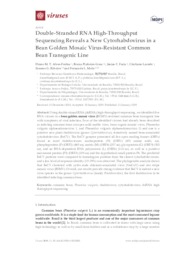Double-stranded RNA high-throughput sequencing reveals a new Cytorhabdovirus in a bean golden mosaic virus-resistant common bean transgenic line.
Double-stranded RNA high-throughput sequencing reveals a new Cytorhabdovirus in a bean golden mosaic virus-resistant common bean transgenic line.
Author(s): ALVES-FREITAS, D. M. T.; PINHEIRO-LIMA, B.; FARIA, J. C.; LACORTE, C.; RIBEIRO, S. G.; MELO, F. L.
Summary: Using double-strand RNA (dsRNA) high-throughput sequencing, we identified five RNA viruses in a bean golden mosaic virus (BGMV)-resistant common bean transgenic line with symptoms of viral infection. Four of the identified viruses had already been described as infecting common bean (cowpea mild mottle virus, bean rugose mosaic virus, Phaseolus vulgaris alphaendornavirus 1, and Phaseolus vulgaris alphaendornavirus 2) and one is a putative new plant rhabdovirus (genus Cytorhabdovirus), tentatively named bean-associated cytorhabdovirus (BaCV). The BaCV genome presented all five open reading frames (ORFs) found in most rhabdoviruses: nucleoprotein (N) (ORF1) (451 amino acids, aa), phosphoprotein (P) (ORF2) (445 aa), matrix (M) (ORF4) (287 aa), glycoprotein (G) (ORF5) (520 aa), and an RNA-dependent RNA polymerase (L) (ORF6) (114 aa), as well as a putative movement protein (P3) (ORF3) (189 aa) and the hypothetical small protein P4. The predicted BaCV proteins were compared to homologous proteins from the closest cytorhabdoviruses, and a low level of sequence identity (15?39%) was observed. The phylogenetic analysis shows that BaCV clustered with yerba mate chlorosis-associated virus (YmCaV) and rice stripe mosaic virus (RSMV). Overall, our results provide strong evidence that BaCV is indeed a new virus species in the genus Cytorhabdovirus (family Rhabdoviridae), the first rhabdovirus to be identified infecting common bean.
Publication year: 2019
Types of publication: Journal article
Unit: Embrapa Rice & Beans
Observation
Some of Embrapa's publications are published as ePub files. To read them, use or download one of the following free software options to your computer or mobile device. Android: Google Play Books; IOS: iBooks; Windows and Linux: Calibre.
Access other publications
Access the Agricultural Research Database (BDPA) to consult Embrapa's full library collection and records.
Visit Embrapa Bookstore to purchase books and other publications sold by Embrapa.

